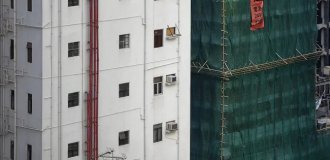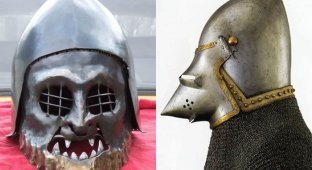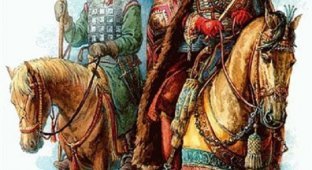I present to you a small selection of armor and weapons.

Neither soft armor, nor leather, nor chain mail provided adequate protection to the warrior. The optimal ratio of weight to level of protection could be provided by a solid metal plate 1.2-2 millimeters thick. But the technology to enable the mass production of armor from such plates was not available in Europe until the 15th century. And in the rest of the world much later. In order to forge a flat blade from three strips of metal, great skill was already required. A three-dimensional object (helmet or cuirass) is much more difficult to produce with one forging process. Sometimes craftsmen managed to create a cuirass from several elements, ring segments that were connected to each other. But such a product was a literal work of art, and was an exception to the general rule. Craftsmen capable of forging a large and reliable armor element (especially a curved one) from several layers of metal practically did not exist in Europe until the 14th century.


Although the very first armor can be attributed to the bronze anatomical armor of Ancient Greece, Rome and the Japanese tanko armor. But due to its design features, such armor was intended exclusively for combat on foot, or at least from a chariot. It was impossible to sit on a horse in them. In addition, such armor weighed as much as it cost. Crazy a lot. And they were inaccessible to most warriors. Sometimes they were replaced in Greece and Rome with anatomical leather armor. And anatomical bronze armor was available only to military leaders.


In Europe, since the 13th century, chain mail was reinforced with extensive shoulder and chest plates (when the warrior, the owner of the armor, allowed this). In addition to breastplates and shoulder pads, bracers, leggings, legguards and other elements were made from solid metal. Most often, solid armor elements were supplemented with chain mail or leather fragments. Europe realized the benefits of rigid booking early. The masters did not stop implementing new ideas until they brought the principle to its logical conclusion, making plate armor truly solid.
The armor of the Polish hussar imitates the segmented plate armor of an earlier period.

And the knights now wanted to have such and only such armor. This was due to the tactics of the knightly cavalry. The heavy cavalry charged in close formation several ranks deep. At the same time, the king often considered it important to be in the front row. Indeed, according to European tradition, representatives of the wealthiest class - the highest aristocracy - not only personally participated in battles, but also, in their absence, had to fight in tournaments every year. And what will happen to the commander, galloping ahead on a dashing horse, if he is knocked out of the saddle? The rider will crash right under the feet of his own squire’s horse, and compared to the blow of a shod hoof, any club is nothing! Full articulated armor not only provided a high level of protection in hand-to-hand combat. Most importantly, they served as a kind of exoskeleton (similar to the natural shell of beetles), and thereby sharply increased the survivability of a warrior forcibly dismounted during a cavalry battle. And right under the hooves.

The first “classic” plate knight armor appeared back in the 13th century. Moreover, these were segmented armor. Articulated from several smaller elements. And even at that time, such armor was available only to kings. And that’s not for everyone. Since the 14th century, counts and dukes could afford full plate armor, and in the 15th century this pleasure became available to knights. Fortunately, the development of metallurgy in Europe made it possible to provide everyone with the necessary amount of metal. And forges with a hammer from a water wheel became widespread. Which led to the fact that in the wars of the 15th century, the number of knights killed, even in large battles that determined history, was counted in just a few. So in the battle between Spain and the union of Italian states, as a result of which Italy became part of the Spanish possessions, only two knights died. And then one of them choked. Managed to fall off his horse into a stream.



Solid armor of the 15th century was guaranteed to protect against arrows fired from a bow from any distance. At a distance of more than 2
5-30 meters of armor could withstand crossbow bolts and arquebus bullets. They were not penetrated by darts, spears and swords, and reliably protected from blows from crushing weapons. They could only be penetrated with heavy two-handed weapons - two-handed swords and axes, pikes and weapons specially created for fighting plate armor, such as halberds. And to neutralize a warrior in plate armor, it was necessary to strike him at least 6 - 8 blows.
Unfortunately, such armor also had disadvantages, the most significant of which, and significant in the literal sense, was the load on the warrior. The shell weighed up to 25 kg. If chain mail was worn underneath, which was generally accepted until the end of the 15th century, then the total mass of the protective equipment reached 32 kilograms! A warrior clad in such heavy armor was significantly limited in mobility. In individual foot combat, armor was more of a hindrance than a help. In this case, a meeting with a lightly armed enemy who had a long weapon with great penetrating power did not bode well for the foot knight.

Armor of the 15th century was forged using a hammer driven by a water wheel. This made it possible to make larger plates. After the plates were forged, they were brought to the desired shape by hand. Moreover, the plates could not be the same in thickness. A thicker layer of metal was made in the most critical areas of the armor. In Europe of the 15th century, two types of armor became most widespread: rounded and smooth “Milanese”, which were made in Milan, and more chopped and angular “Gothic”, the manufacturing centers of which were Ausburg, Nuremberg and the Tyrol region. Which was determined by the quality of the raw materials used. The armor of other European countries was less valuable. At the same time, English armor had the least value.

But standard combat armor of this period remained relatively light. And they made it possible to wear them comfortably for quite a long time. Naturally, provided that elements such as a helmet, mittens/gloves and shins were removed whenever possible. Such armor had a competent system of fastening and weight distribution; a trained person experienced virtually no inconvenience when handling it and could not only climb on and off a horse without the help of a page, but also calmly conduct maneuverable foot combat. The myth that a knight in such armor who fell from the saddle could not get up on his own is also groundless. He stood up if he did not lose consciousness from falling.

Due to the high price, armor was often purchased in several stages, or replenished from trophies. Therefore, complete sets were quite rare. In general, armor was produced in various price categories. From relatively cheap, for ordinary soldiers. And sometimes with separate elements in the form of breastplates, cuirasses, bracers, shoulder pads, knee pads, gloves. And called Landsknecht armor. To expensive and high-quality complete sets for knights and captains.

A typical landsknecht's armor consisted of a cuirass with a necklace and legguards, which provided the only protection for the legs. Plate bracers of a simplified design were often part of the armor. Attached to the necklace were shoulder pads that reached to the elbow. By the 17th century, armor in the form of simplified cuirasses and helmets was used only by pikemen. Cheap armor usually weighed about 12 kg.



Requirements for the strength of armor increased significantly in the 16th century, because firearms were already used. Which led to the appearance of the so-called Maximilian armor, named after Emperor Maximilian I. And having a claim to maximum protection. This was German armor from the first third of the 16th century. In appearance, Maximilian armor is similar to Italian armor, but was created in Germany/Austria under the influence of Italian armor, famous for its reliability and protection (in return for sacrificing freedom of movement). With external contours that make it similar to Milanese armor, it has design features inherited from German Gothic armor, which make it possible to obtain a more durable structure with less weight. At the same time, the armor, unlike the Gothic, but like the Milanese, was made not from small, but from large plates, which is associated with the spread of firearms, because of which it was necessary to sacrifice the famous flexibility and freedom of movement of the Gothic armor for the sake of the ability to withstand a bullet fired from distances.

As a result, armor at the very end of its evolution
jutsions reached a weight of 33 kg. The chain mail was no longer worn under them, but this made it possible to increase the thickness of the armor plates to 3 mm. The material used was steel. Giving the armor of this period the romantic name "white armor". “White armor” is all-plate armor made of polished steel that sparkled in the sun and therefore seemed “white.” Sometimes even arquebus bullets and crossbow bolts pierced the shell of the 16th century only when fired at point-blank range.
Special tournament armor, the “frontal armor” of which reached a centimeter thickness, had much greater strength. In principle, they did not respond to any modern weapon, but they also weighed up to 80 kg, and the mobility of the warrior in them was limited by the ability to slightly move his right hand while aiming the spear. Yes, in them, the fallen knight could not get up. And he didn’t climb the horse himself. And with the help of a crane.

Historical greaves and modern reconstruction.

In addition to combat or tournament armor, the so-called ceremonial or costume armor also appeared at the same time. Which were made as light as possible due to the thickness of the metal. And they were distinguished by rich decoration, including engraving.
The production of plate armor reached its true heyday in Europe only in the first half of the 17th centuries, when they were made from blast furnace iron and were used primarily to decorate castle interiors. However, decorative armor remained quite functional.

In Japan, armor made from segments also became widespread. But the size of the plates in them was much smaller. The technologies that existed in the Land of the Rising Sun were then significantly inferior to those in Europe. As a result, the number of plates could reach several dozen. Representing an analogue of European segmented plate armor of the 13th-14th centuries. Medieval Japanese technology could not rise higher. And such armor was not available to everyone in Japan. Most samurai used fabric, or even paper or bamboo soft armor.

No, and in Japan there was very expensive and prestigious armor based on an imported Spanish cuirass and a Spanish helmet (supplemented with a Japanese backplate). Literally, such armor was called in Japan “armor of the southern barbarians”, sometimes complete with European shoulder pads, worn with Japanese parts of armor. At the same time, in order to avoid rust, imported parts of the armor were coated with varnish (often colored). What is curious is that the helmet was put on backwards (the backplate was attached by Japanese craftsmen in such a way that after that the helmet could only be worn backwards, but the crest of the helmet was in front), and the plate necklace was worn not under (as usual in Europe), but ostentatiously on the cuirass .
In addition to the original imported armor, there were also imitations. Literally “pigeon chest” - armor with a convex stiffening rib in the middle of the chest, created under the impression of Spanish cuirass, but in the Japanese manner and in the Japanese style. Unlike the Spanish cuirass, the stiffening rib could have additional riveted reinforcement, and the cuirass itself could be made of segmented stripes. Typically, such armor was worn complete with Japanese pointed helmets, created under the impression of the Spanish ones.

The armor required constant maintenance. Torn belts, broken buckles, and torn rivets were immediately replaced. Damage to the fastenings, not noticed in time, rendered the armor practically useless. The armor rusted easily. And the rusted armor did not protect its owner. At the same time, armor cost a lot of money. So their appearance had to be maintained not only for reasons of prestige. The armor was constantly treated with pumice and rubbed with olive oil. As a result, the surface of the armor was literally polished to a mirror shine. But other methods of protecting armor from corrosion were also used. They were tinned, and a lubricant of fat and soot was applied to the armor. Various types of bluing, blackening or painting were also used. Often, to protect from scratches and moisture, the outside of the cuirass was covered with leather. A fabric jacket, “vapenrok,” could also be worn over the armor. Armor was transported wrapped in cloth or placed in straw in barrels or baskets.

Plate armor could only be put on with outside help. And they were worn only over special clothing. Similar to the one that was worn under chain mail (I will not repeat myself, see my previous post). The first to wear a plate or chain mail gorget, fastened with straps with buckles at the back or side, and representing
a stand-up collar made of plates.

Tight-fitting chain mail “shorts” were tied to the leggings with straps. Then they put on greaves that protected the lower leg. Next came knee pads and leg guards, which were not only attached to the leg with straps, but also tied to the top of the stockings. Completing the protection of the legs were sabatons - plate boots attached to the greave.

The chest and back plates of the cuirass were fastened on the right side using belts with buckles. A cape was hung from the cuirass. Which covered the joint with the shoulder. The mantles and bracers were fastened with belts with buckles and tied to the sleeves of the camisole.

As a rule, bracers consisted of four parts: a mantle, a shoulder pad, an elbow pad, and the bracer itself. The last thing to wear were plate gloves. Spurs, helmet, shield and weapons completed the equipment. But this is how a warrior was equipped for mounted combat. For foot combat, they tried to reduce the weight of the armor. Usually by refusing to protect the legs.


Well, armor for a modern knight.


























